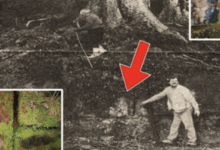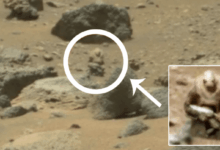Astronauts Saw Something Moving on the Moon & And It’s Still There
Astronauts Saw Something Moving on the Moon & And It’s Still There
#23 – A Glowing Object Moving on the Moon
A shocking video captured a bright object moving across the Moon’s surface. The strange thing? It wasn’t falling debris or floating dust—because the Moon has no atmosphere to create wind. The movement seemed deliberate, sparking wild speculation online: was it alien technology or an unknown entity? Some skeptics claim it’s just an illusion of light and shadow, but there are still unexplained anomalies that keep this mystery alive.
#22 – The Mysterious Cube
In December 2021, China’s Yutu-2 rover discovered a strange cube-shaped object on the Moon’s far side—something straight out of Minecraft! Dubbed the “mystery house,” the internet exploded with theories: an alien base, a hidden research station, or even a forgotten Hollywood prop? But after weeks of moving closer, it turned out to be… just a bizarrely shaped rock.
#21 – The Self-Moving Rocks
With no water or wind on the Moon, how do some rocks leave long tracks behind them? Apollo 17 astronauts once found a giant boulder that appeared to have rolled for hundreds of meters, jokingly calling it the “Lunar Bowling Ball.” The most accepted theory? Moonquakes—small seismic tremors on the Moon. But some tracks are so straight and long that they defy easy explanation. Could something else be moving them?
#20 – The Mysterious Zigzag Lights
Since the 18th century, astronomers have reported seeing unexplained flashes of light on the Moon, known as Transient Lunar Phenomena (TLP). These flashes appear for seconds before vanishing without a trace. Some believe they result from gas escaping from underground or meteorite impacts. But even astronaut Buzz Aldrin reported seeing strange lights while orbiting the Moon. This mystery remains unsolved.
#19 – The “Gel” Discovery
In 2019, the Yutu-2 rover found something astonishing in a small crater—a shiny, gel-like substance. Since the Moon is dry and covered in dust, this discovery was shocking. The leading theory suggests it could be molten glass formed from meteorite impacts, but its texture and color don’t match any known samples. Scientists are still unsure what it really is.
#18 – Mysterious Tracks on the Surface
NASA images reveal unexplained tracks on the Moon—yet there are no objects nearby to explain them. Only 12 astronauts have ever walked on the Moon, so who or what made these tracks? Some suggest that temperature changes cause rocks to shift, but some trails are so straight that they look as if someone—or something—has been walking across the surface.
#17 – The Strange Standing Monolith
In 1966, a NASA probe captured an image of a tall, vertical object casting a long shadow on the Moon. It looked like a giant stone pillar—or even a man-made structure! Some believe it could be a sign of an ancient extraterrestrial civilization, with theories suggesting it might even be a cosmic transmission station. Scientists argue that it could be a naturally occurring rock formation, but strangely, no other similar objects have ever been found.
#16 – The American Flag Still Standing
When Neil Armstrong and Buzz Aldrin planted the U.S. flag on the Moon in 1969, it became an iconic moment in history. But with no wind on the Moon, why did the flag appear to be waving? NASA explained that they used a horizontal rod to hold it up. However, decades later, satellite images show that the flag is still standing—despite being exposed to harsh solar radiation. Could it be made of some special material?
#15 – Moonquakes
Even though the Moon lacks tectonic plates like Earth, it still experiences earthquakes—called moonquakes. Some are thought to be caused by Earth’s gravitational pull, but others seem to happen for no clear reason. This has led to theories that the Moon’s interior might be hollow—or hiding something unknown.
#14 – Ancient Glass Beads
The Moon’s surface is scattered with tiny glass beads, formed by ancient volcanic eruptions and meteorite impacts. These mysterious remnants not only help scientists understand the Moon’s history but could also become valuable resources if humans ever begin lunar mining.




